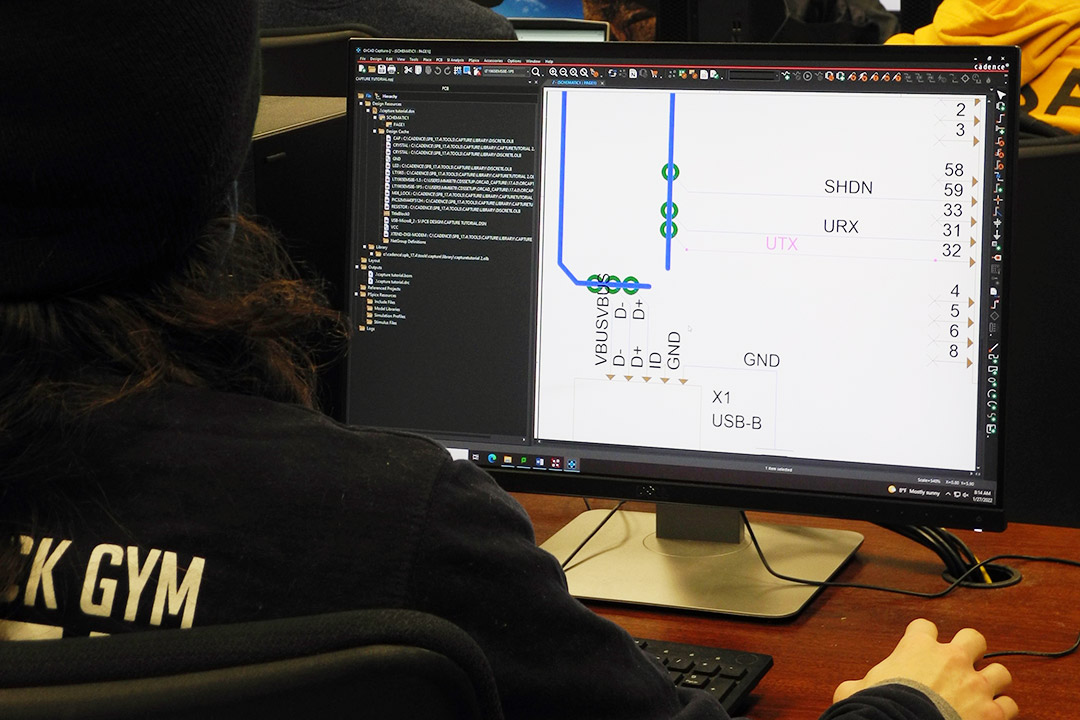RIT partners with industry experts on new curriculum in electronics design and manufacturing
Printed circuit board coursework will provide needed skills to fill expected industry gaps
M. Cometa
Students are designing printed circuit boards and learning from industry experts.
EMA Design Automation, Cadence Design Systems Inc., and Rochester Institute of Technology are collaborating to provide college-level printed circuit board (PCB) design courses for students in RIT’s College of Engineering Technology.
Taught both online and in-person by PCB design industry experts, the courses can provide engineers with training and development opportunities in key areas of electronics design and manufacturing.
Within the next 15 years, 78 percent of PCB designers will no longer work in the field due to retirements, according to Printed Circuit Design & Fab magazine’s annual industry survey. With a critical shortage in trained PCB professionals, this college-industry collaboration can provide today’s students with the skills to meet manufacturing demands.
“Ongoing learning is essential in acquiring the critical skills and specialized knowledge necessary to succeed in tomorrow’s workforce,” said David Junkin, Academic Network Program Director for Cadence. “Cadence is proud to support both EMA and RIT in their efforts to make learning PCB design easily accessible to new engineers. With knowledge and understanding of this critical skill, they can continue to solve complex technological challenges and drive innovation for the next generation of electronic devices.”
EMA Design Automation sponsored the creation of this new curriculum, which was developed and reviewed by a team of PCB design experts. Cadence donated its OrCAD software for the course, allowing for hands-on design instruction. EMA is also offering students the chance to become OrCAD certified as part of this course; the software is utilized extensively in manufacturing today.
“I decided to take this course to have a more formal understanding of PCB design and to learn the different software packages from OrCAD,” said Noah Carrier, one of the dozen students currently in the pilot course this spring semester. “All my PCB design experience is self-taught on the job, so I don't exactly have an algorithmic way of attacking new designs. My hope from this class is that I have more knowledge to work with new and exciting technologies with a formal PCB design education. That is how I hope it will further my career.”
M. Cometa
Noah Carrier, an undergraduate student in RIT’s College of Engineering Technology, and his classmates are learning skills in printed circuit design as part of a new course developed with industry experts.
The general topics in the classes are electrical schematic capture techniques, PCB design techniques, PCB manufacturing knowledge, and other PCB-specific design constraints. With this background, Carrier and his classmates may qualify for the certification offered by the company, “a nice bonus to the knowledge gained,” said Carrier, a fifth-year computer engineering technology student from Rockland, Maine. He participated in a co-op and as a part-time employee at the Laboratory for Laser Energetics at the University of Rochester. He’ll begin work as a laboratory engineer after graduation in May.
Built upon concepts taught in the popular Hitchhiker’s Guide to PCB Design book, the curriculum provides training and development opportunities in design and manufacturing fundamentals, CAD software familiarity, incorporating design for manufacturing. This further solidifies EMA’s commitment to empower engineers and support the worldwide EDA market through education, said Manny Marcano, president and chief executive officer of EMA Design Automation.
“EMA is committed to supporting the next generation of engineers by providing them with the skills they need to meet current industry demands,” Marcano added. “Students want to excel in the workplace, and our goal is to empower them with access to training and courses that will help them acquire the skills employers are actively looking for.”
James Lee, acting department chair for RIT’s Department of Electrical and Computer Engineering Technology, agreed. This course combines both theory and application, and students are finding that it can potentially give them an edge in growing fields needing next generation PCBs.
“RIT is leading the way by continuing to provide timely and relevant learning opportunities that address in-demand knowledge and skills,” said Lee. “Our collaboration with EMA allows us to do just that. This curriculum will provide engineers with a combination of the technological and higher-level skills necessary to succeed in this rapidly changing industry.”








